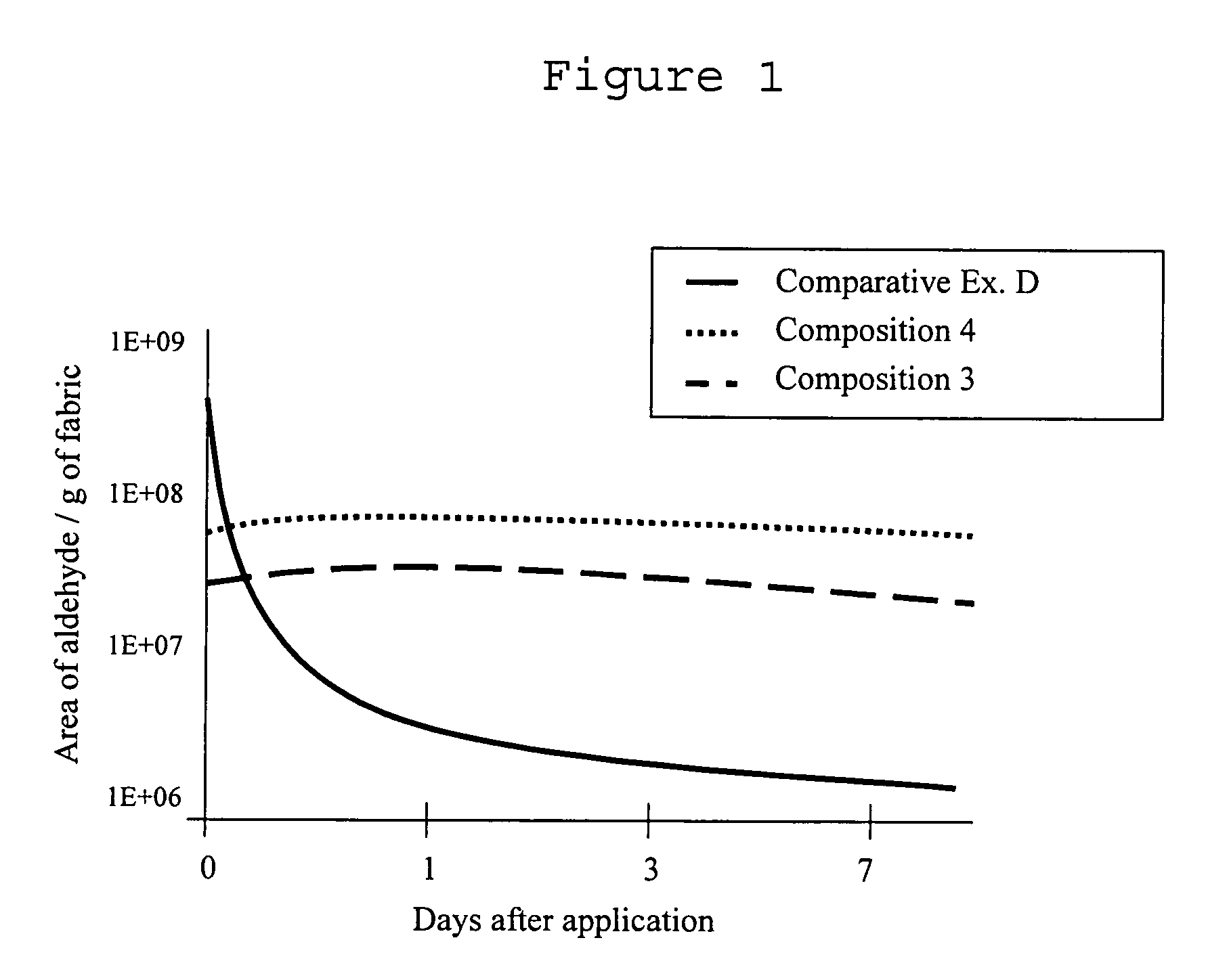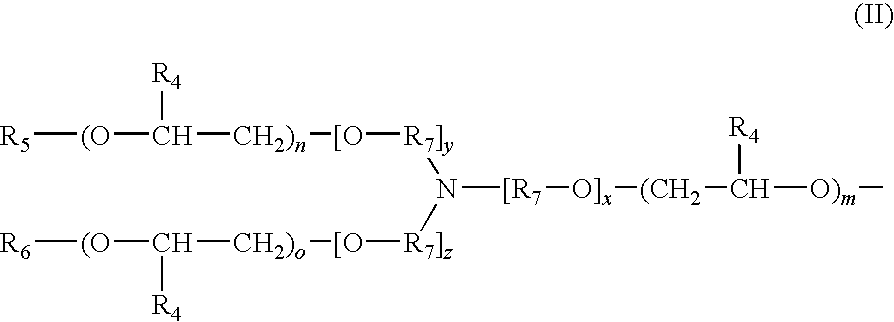Fragrance precursor
a precursor and fragrance technology, applied in the field of fragrance precursors, can solve the problems of inability to use techniques, the fragrance is lost in the aqueous phase, and the fragrance tends to be dissipated very quickly
- Summary
- Abstract
- Description
- Claims
- Application Information
AI Technical Summary
Benefits of technology
Problems solved by technology
Method used
Image
Examples
example 1
Condensation of C10 Aldehyde with an Ethoxylated Esteramine
[0173]In a reaction flask equipped with a stirrer and a temperature probe, 50 g (0.0491 moles) of an ethoxylated esteramine derived from triethanolamine and oleic acid having on average 5.5 moles of ethylene oxide per hydroxyl group were heated at 50° C. in an oil.
[0174]Later, 0.1327 g (0.00737 moles) of water and 0.0845 g (0.00049 moles) of p-toluenesulfonic acid monohydrate were added keeping the temperature at 50° C.
[0175]Finally, 11.52 g (0.0737 moles) of decanal (decyl aldehyde) were added slowly during 1-2 hours keeping the temperature at 50° C.
[0176]Upon completion of the addition, stirring of the reaction mixture continued for further 3 hours at 50° C.
[0177]The reaction mixture was maintained overnight at 50° C. The reaction mixture was then cooled to room temperature.
example 2
Condensation of C10 Aldehyde with an Ethoxylated Amine
[0178]In a reaction flask equipped with a stirrer and a temperature probe, 40 g (0.0671 moles) of an ethoxylated di-lauryl amine having on average 5.5 moles of ethylene oxide were heated at 60° C. in an oil bath until said ethoxylated amine was melted.
[0179]Later, 0.1813 g (0.01007 moles) of water and 0.1155 g (0.00067 moles) of p-toluenesulfonic acid monohydrate were added keeping the temperature at 60° C.
[0180]Finally, 15.74 g (0.1007 moles) of decanal (decyl aldehyde) were added slowly during 1-2 hours keeping the temperature at 60° C.
[0181]Upon completion of the addition, stirring of the reaction mixture continued for further 3 hours at 60° C. The reaction mixture was maintained overnight at 60° C. The reaction mixture was then cooled to room temperature.
example 3
Condensation of C11 Aldehyde with an Ethoxylated Esteramine
[0182]In a reaction flask equipped with a stirrer and a temperature probe, 50 g (0.0491 moles) of an ethoxylated esteramine derived from triethanolamine and oleic acid having on average 5.5 moles of ethylene oxide per hydroxyl group were heated at 50° C. in an oil.
[0183]Later, 0.1327 g (0.00737 moles) of water and 0.0845 g (0.00049 moles) of p-toluenesulfonic acid monohydrate were added keeping the temperature at 50° C.
[0184]Finally, 12.41 g (0.0737 moles) of undec-10-enal (undec-10-enyl aldehyde) were added slowly during 1-2 hours keeping the temperature at 50° C.
[0185]Upon completion of the addition, stirring of the reaction mixture continued for further 3 hours at 50° C.
[0186]The reaction mixture was maintained overnight at 50° C. The reaction mixture was then cooled to room temperature.
PUM
| Property | Measurement | Unit |
|---|---|---|
| temperatures | aaaaa | aaaaa |
| temperatures | aaaaa | aaaaa |
| temperatures | aaaaa | aaaaa |
Abstract
Description
Claims
Application Information
 Login to View More
Login to View More - R&D
- Intellectual Property
- Life Sciences
- Materials
- Tech Scout
- Unparalleled Data Quality
- Higher Quality Content
- 60% Fewer Hallucinations
Browse by: Latest US Patents, China's latest patents, Technical Efficacy Thesaurus, Application Domain, Technology Topic, Popular Technical Reports.
© 2025 PatSnap. All rights reserved.Legal|Privacy policy|Modern Slavery Act Transparency Statement|Sitemap|About US| Contact US: help@patsnap.com



